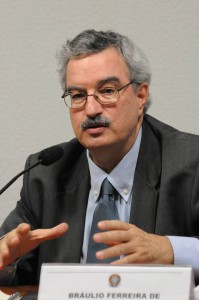Biological diversity and ecosystems last week featured prominently in the proposal of a set of 17 Sustainable Development Goals (SDGs) that the Open Working Group on Sustainable Development Goals of the 68th session of the United Nations General Assembly agreed by acclamation to forward to the General Assembly, setting the stage for better links between the implementation of the biodiversity agenda of the Convention on Biological Diversity (CBD), and the post-2015 sustainable development agenda.

“The results demonstrate the growing recognition that biodiversity is essential for sustainable development. Now we need to ensure that biodiversity remains strongly in the final outcomes for the post-2015 agenda. We further need to ensure that the implementation of these goals and targets is done in a meaningful and effective manner,” said Braulio Ferreira de Souza Dias, Executive Secretary of the CBD.
The outcome of the deliberations of the Open Working Group is extremely positive from the perspective of the Convention on Biological Diversity and the implementation of the Strategic Plan for Biodiversity 2011-2020 and the Aichi Biodiversity Targets. Biodiversity and ecosystems are included throughout the proposed SDGs. There are two goals directly related to biodiversity: Goal 14 on oceans and coasts, and Goal 15 on terrestrial biodiversity. Goal 12 on sustainable consumption and production is also very relevant to the Strategic Plan.
Language referring to biodiversity and ecosystems and/or natural resources is also included in many other goals, including Goal 2 on food security, Goal 6 on water and sanitation, and Goal 11 on cities and human settlements. Other goals which include “sustainability” considerations are also of relevance, as is Goal 17 on means of implementation.
The language in the chapeau underscores that conservation, sustainable use and equitable sharing of benefits are at the heart of the sustainable development process. Paragraph 3 states: “Poverty eradication, changing unsustainable and promoting sustainable patterns of consumption and production and protecting and managing the natural resource base of economic and social development are the overarching objectives of and essential requirements for sustainable development.”
One of the most important achievements is the inclusion in Goal 15 of target 15.9 “by 2020, integrate ecosystems and biodiversity values into national and local planning, development processes and poverty reduction strategies, and accounts.” This target is key as it makes a strong linkage between biodiversity, sustainable development and poverty eradication.
The co-chairs of the Open Working Group – Ambassador Csaba Kőrösi of Hungary and Ambassador Macharia Kamau of Kenya – will forward the text of 17 goals and 169 targets as a report to the General Assembly. This outcome will form an important part of the Secretary General’s “synthesis report” on SDGs and the post-2015 agenda, which will lay out the final steps for completing the post-2015 package in 2015, bringing together different processes that have been ongoing: one on SDGs, one on the post-2015 agenda, and one that includes the Intergovernmental Committee of Experts on Sustainable Development Financing, supported by the Working Group on Financing for Sustainable Development.
“The co-chairs need to be congratulated for their tireless efforts and their deft ability to guide the discussions over the last months” said Braulio Ferreira de Souza Dias. “Thanks to their work and skill, the world is engaged in one coordinated conversation on one of the most important outcomes of the Rio+20 conference.”
These results are directly relevant to the theme of the upcoming twelfth meeting of the Conference of the Parties to the Convention on Biological Diversity (COP-12) and it’s High Level Segment – Biodiversity for Sustainable Development, and point to the growing recognition outside of the traditional biodiversity community of the essential role of biodiversity to achieving sustainable development.
When Parties to the CBD meet in Pyeongchang, COP-12 and the High Level Segment will provide opportunities to further reinforce and integrate the agenda of the CBD with that of the post-2015 process and of SDGs. It is expected that a number of COP-12 decisions, related to oceans, forests, biodiversity for development and others, as well as the many parallel meetings and side events will have the potential to contribute to advancing and implementing the goals and targets proposed under the SDG process. The Pyeongchang Roadmap, an anticipated result from COP-12, will also be important to ensuring that the biodiversity and the post-2015 agendas are more closely linked. The declaration of the High Level Segment is also expected to be transmitted to the United Nations General Assembly, and provide additional elements to the discussions on the post-2015 process and the SDGs.
To highlight the essential role of biodiversity for sustainable development, the Secretariat has chosen to celebrate the International Day for Biological Diversity on 22 May 2015 under the theme of “Biodiversity for Sustainable Development.”
The CBD opened for signature at the Earth Summit in Rio de Janeiro in 1992 and entered into force in December 1993. It is an international treaty for the conservation of biodiversity, the sustainable use of the components of biodiversity and the equitable sharing of the benefits derived from the use of genetic resources. With 194 Parties up to now, the Convention has near universal participation among countries.
The CBD seeks to address all threats to biodiversity and ecosystem services, including threats from climate change, through scientific assessments, the development of tools, incentives and processes, the transfer of technologies and good practices and the full and active involvement of relevant stakeholders including indigenous and local communities, youth, NGOs, women and the business community.
The Cartagena Protocol on Biosafety is a supplementary agreement to the Convention. It seeks to protect biological diversity from the potential risks posed by living modified organisms resulting from modern biotechnology. To date, 166 countries plus the European Union have ratified the Cartagena Protocol. The Secretariat of the Convention and its Cartagena Protocol is located in Montreal, Canada.
